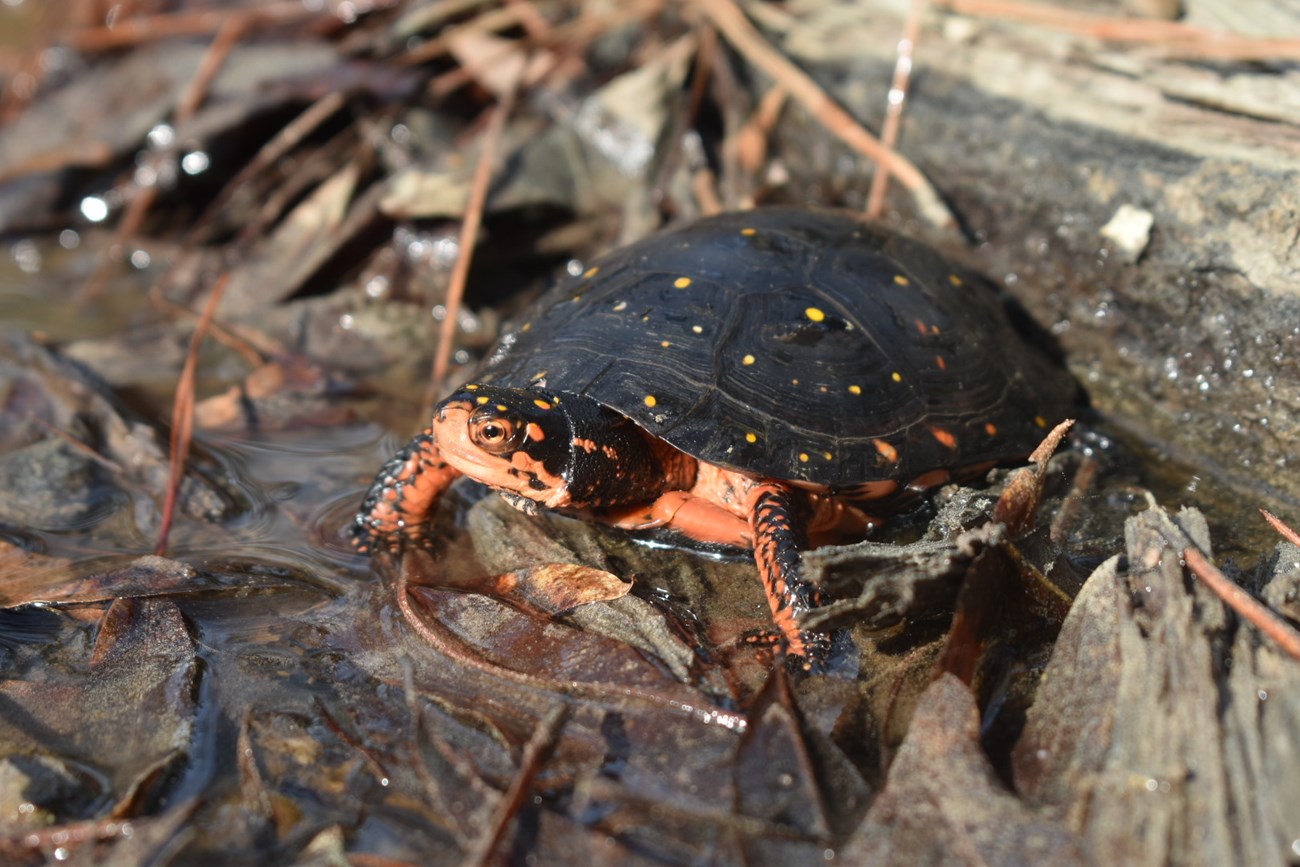Last updated: June 3, 2024
Article
At-Risk Turtles - Ongoing Research Spotlight

Max Jones
Slowing Down to Observe Turtles
Parks are good places to escape the hectic pace of our day-to-day lives, slow down a bit, and consider the natural world. Perhaps, to enjoy observing turtles in their natural habitat!
Turtles are susceptible to stressors including habitat loss, illegal collecting, and rapid changes in climate to name a few. That’s why NPS is now studying them to help ensure they can survive into the future.
Spotted, Wood, and Box Turtles
A study is now underway in five mid-Atlantic national parks with collaborators from Virginia Tech, focusing on three imperiled and vulnerable turtle species: the spotted and wood turtles (under consideration for federal listing) and the eastern box turtle (a state species of greatest conservation concern). Next year the study will expand to 15 parks including: Catoctin Mountain Park, C&O Canal National Historical Park, George Washington Memorial Parkway, Harpers Ferry National Historical Park, National Capital Parks - East, Prince William Forest Park, and Rock Creek Park in the greater DC area; Upper Delaware Scenic & Recreational River, Valley Forge National Historical Park, and Hopewell Furnace National Historic Site in the northeast; and Congaree National Park, Cape Hatteras National Seashore, and Cape Lookout National Seashore in the southeast.
The study aims to learn more about these species and will incorporate genetic sampling of regional populations, disease sampling, physical measurements, mapping of individuals, shell photography, and reproductive assessment of females using a portable veterinary x-ray.
Fear For the Turtle
Wood turtle populations are declining rapidly, with many studies reporting declines of up to 50% in less than ten years. Studies of spotted turtles and eastern box turtles report declines when populations face multiple stressors such as high park visitation rates, road mortality, nonnative invasive species, reduced habitat connectivity due to climate change, and poaching. All three species have been targeted by illegal collectors and hundreds to thousands of turtles have been rescued by law enforcement.
The Threat of Illegal Collection
Illegal collection is a dire threat to turtles. Even if the turtles are rescued, we often don’t know where they came from. According to a coverage of a 2022 turtle smuggling case by the US Fish and Wildlife Service, “When turtles have been confined together in unnatural conditions, like boxes, it’s risky to let them go, especially if you don’t know where they came from. They can introduce diseases or muddy the gene pool of populations that have adapted to survive in certain places over generations. Likewise, the released turtles are not likely to survive in unfamiliar landscapes.” Instead rescued turtles are often placed with partners who can professionally care for them, but they are lost forever to their home habitats.
Since it typically takes turtles a decade or more to reach reproductive age, and most hatchlings don’t survive, the impact of poaching has profound and lasting effects on turtle populations.
The Project
This project, Assessing At-Risk turtles on Mid-Atlantic NPS Lands to Inform Conservation and Management, began in 2024 and will wrap up in 2026. It is made possible through an agreement with Virginia Tech, a member of the Chesapeake Watershed Cooperative Ecosystem Studies Unit and is funded by the NPS partner, the National Park Foundation.
The CW CESU promotes stewardship and integrated ecosystem management of natural and cultural resources in the Chesapeake Watershed through collaborative research, technical assistance, and education. To learn more about the CW CESU, please contact Dan Filer at 301-491-2465 or browse the CW CESU Newsletter.
Tags
- cape hatteras national seashore
- cape lookout national seashore
- catoctin mountain park
- chesapeake & ohio canal national historical park
- george washington memorial parkway
- harpers ferry national historical park
- hopewell furnace national historic site
- national capital parks-east
- prince william forest park
- rock creek park
- upper delaware scenic & recreational river
- valley forge national historical park
- turtle
- eastern box turtle
- wood turtle
- spotted turtle
- reptiles
- threatened and endangered species
- ncr
- nature
- ongoing research
- cw cesu
- natural resource quarterly
- summer 2024
